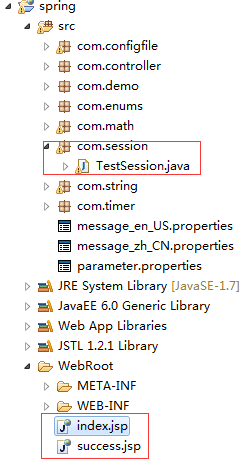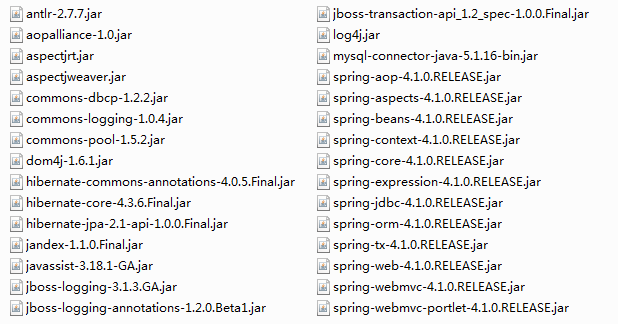Java Session 介绍
一、添加、获取session
1、项目结构

2、jar包

3、web.xml文件
<?xml version="1.0" encoding="UTF-8"?> <web-app xmlns:xsi="http://www.w3.org/2001/XMLSchema-instance" xmlns="http://java.sun.com/xml/ns/javaee" xmlns:web="http://java.sun.com/xml/ns/javaee/web-app_2_5.xsd" xsi:schemaLocation="http://java.sun.com/xml/ns/javaee http://java.sun.com/xml/ns/javaee/web-app_3_0.xsd" id="WebApp_ID" version="3.0"> <display-name>spring</display-name> <context-param> <param-name>contextConfigLocation</param-name> <param-value>/WEB-INF/spring-context.xml,/WEB-INF/applicationContext.xml</param-value> </context-param> <listener> <listener-class>org.springframework.web.context.ContextLoaderListener</listener-class> </listener> <!-- log4j配置文件路径 --> <context-param> <param-name>log4jConfigLocation</param-name> <param-value>/WEB-INF/log4j.properties</param-value> </context-param> <context-param> <param-name>log4jRefreshInterval</param-name> <param-value>6000</param-value> </context-param> <!-- 加载log4j配置文件 --> <listener> <listener-class>org.springframework.web.util.Log4jConfigListener</listener-class> </listener> <!-- springmvc配置 --> <servlet> <servlet-name>springMVC</servlet-name> <servlet-class>org.springframework.web.servlet.DispatcherServlet</servlet-class> <init-param> <param-name>contextConfigLocation</param-name> <param-value>/WEB-INF/spring-config.xml</param-value> </init-param> <load-on-startup>1</load-on-startup> </servlet> <servlet-mapping> <servlet-name>springMVC</servlet-name> <url-pattern>/</url-pattern> </servlet-mapping> <welcome-file-list> <welcome-file>index.html</welcome-file> <welcome-file>index.htm</welcome-file> <welcome-file>index.jsp</welcome-file> <welcome-file>default.html</welcome-file> <welcome-file>default.htm</welcome-file> <welcome-file>default.jsp</welcome-file> </welcome-file-list> </web-app>
4、spring-config.xml文件
<?xml version="1.0" encoding="UTF-8"?> <beans xmlns="http://www.springframework.org/schema/beans" xmlns:xsi="http://www.w3.org/2001/XMLSchema-instance" xmlns:oxm="http://www.springframework.org/schema/oxm" xmlns:context="http://www.springframework.org/schema/context" xmlns:aop="http://www.springframework.org/schema/aop" xmlns:tx="http://www.springframework.org/schema/tx" xmlns:task="http://www.springframework.org/schema/task" xsi:schemaLocation="http://www.springframework.org/schema/beans http://www.springframework.org/schema/beans/spring-beans-3.0.xsd http://www.springframework.org/schema/oxm http://www.springframework.org/schema/oxm/spring-oxm-3.0.xsd http://www.springframework.org/schema/context http://www.springframework.org/schema/context/spring-context-3.0.xsd http://www.springframework.org/schema/tx http://www.springframework.org/schema/tx/spring-tx-3.0.xsd http://www.springframework.org/schema/aop http://www.springframework.org/schema/aop/spring-aop-3.0.xsd http://www.springframework.org/schema/task http://www.springframework.org/schema/task/spring-task-3.2.xsd"> <!-- 通知spring容器通过注解的方式装配bean --> <context:annotation-config /> <!-- 通知spring容器采用自动扫描机制查找注解的bean --> <context:component-scan base-package="com.*" /> <task:annotation-driven /> <!-- 定时器开关--> <bean id="agentExcelTask" class="com.timer.TimerController1"/> <task:scheduled-tasks> <task:scheduled ref="agentExcelTask" method="printstr" cron="* * 0/1000 * * ?"/> </task:scheduled-tasks> <!-- 配置返回页面过滤 --> <bean id="viewResolver" class="org.springframework.web.servlet.view.UrlBasedViewResolver"> <property name="viewClass" value="org.springframework.web.servlet.view.JstlView" /> <property name="prefix" value="/" /> <property name="suffix" value=".jsp" /> </bean> </beans>
5、TestSession.java
package com.session; import javax.servlet.http.HttpServletRequest; import javax.servlet.http.HttpSession; import org.springframework.stereotype.Controller; import org.springframework.ui.Model; import org.springframework.web.bind.annotation.RequestMapping; import org.springframework.web.bind.annotation.SessionAttributes; import com.demo.User; @Controller @SessionAttributes("user") public class TestSession { /** * 用servlet的HttpServletRequest添加信息到session */ @RequestMapping("addSession") public String addSession(User user, HttpServletRequest request, Model model){ request.getSession().setAttribute("user", user); //request.getSession().removeAttribute("user");//删除 session 指定属性健 //request.getSession().invalidate();//清除所有的session,使当前 session 完全失效 User u = (User) request.getSession().getAttribute("user"); model.addAttribute("name", u.getName()); model.addAttribute("password", u.getPassword()); return "success"; } /** * 用servlet的HttpSession添加信息到session */ @RequestMapping("addSession1") public String addSession1(User user, HttpSession request, Model model){ request.setAttribute("user", user); //request.removeAttribute("user");//移除session //request.invalidate();//清除所有的session,使当前 session 完全失效 User u = (User) request.getAttribute("user"); model.addAttribute("name", u.getName()); model.addAttribute("password", u.getPassword()); return "success"; } }
6、index.jsp
<%@ page language="java" import="java.util.*" pageEncoding="UTF-8"%> <%@ taglib prefix="spring" uri="http://www.springframework.org/tags" %> <% String path = request.getContextPath(); String basePath = request.getScheme()+"://"+request.getServerName()+":"+request.getServerPort()+path+"/"; %> <!DOCTYPE HTML PUBLIC "-//W3C//DTD HTML 4.01 Transitional//EN"> <html> <head> <base href="<%=basePath%>"> <title>index</title> </head> <body> <form action="addSession1" method="post"> 用户:<input type="text" name="name"><br><br> 密码:<input type="text" name="password"><br><br> <input type="submit" value="确定"> </form> <!-- 使用message 标签配置需要显示的国际化文本, code 对应国际化文件中对应的键的名称 --> <span style="color: #2D2D2D;"> <spring:message code="main.title"/> </span> <br> <input type="text" value="<spring:message code="main.target"/>"> </body> </html>
7、success.jsp
<%@ page language="java" import="java.util.*" pageEncoding="UTF-8"%> <% String path = request.getContextPath(); String basePath = request.getScheme()+"://"+request.getServerName()+":"+request.getServerPort()+path+"/"; %> <!DOCTYPE HTML PUBLIC "-//W3C//DTD HTML 4.01 Transitional//EN"> <html> <head> <base href="<%=basePath%>"> <title>success</title> </head> <body> ${name},success. <br> 用户名:${name},密码:${password} </body> </html>
二、设置session超时的3中方式
1. 在web容器中设置(此处以tomcat为例)
在tomcat-5.0.28confweb.xml中设置,以下是tomcat 5.0中的默认配置:
<session-config> <session-timeout>30</session-timeout> </session-config>
Tomcat默认session超时时间为30分钟,可以根据需要修改,负数或0为不限制session失效时间。
2. 在工程的web.xml中设置
<!-- 时间单位为分钟 -->
<session-config>
<session-timeout>15</session-timeout>
</session-config>
3. 通过java代码设置
session.setMaxInactiveInterval(30*60);//以秒为单位
三种方式优先级:1 < 2 <3